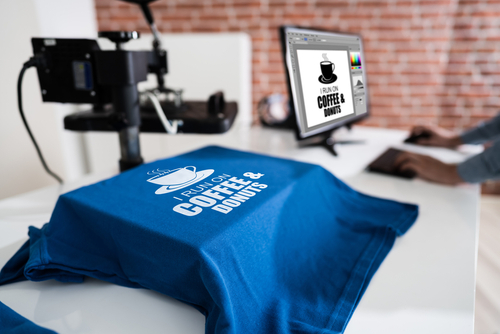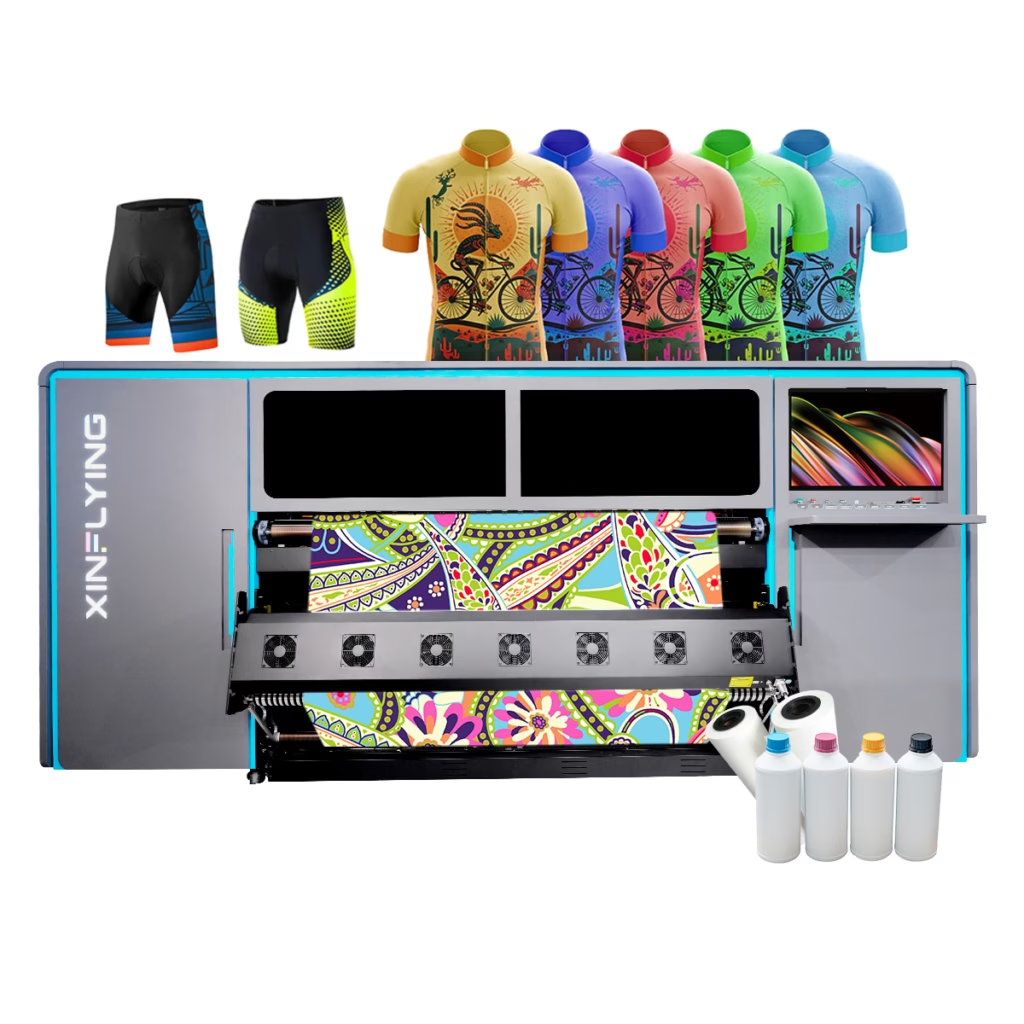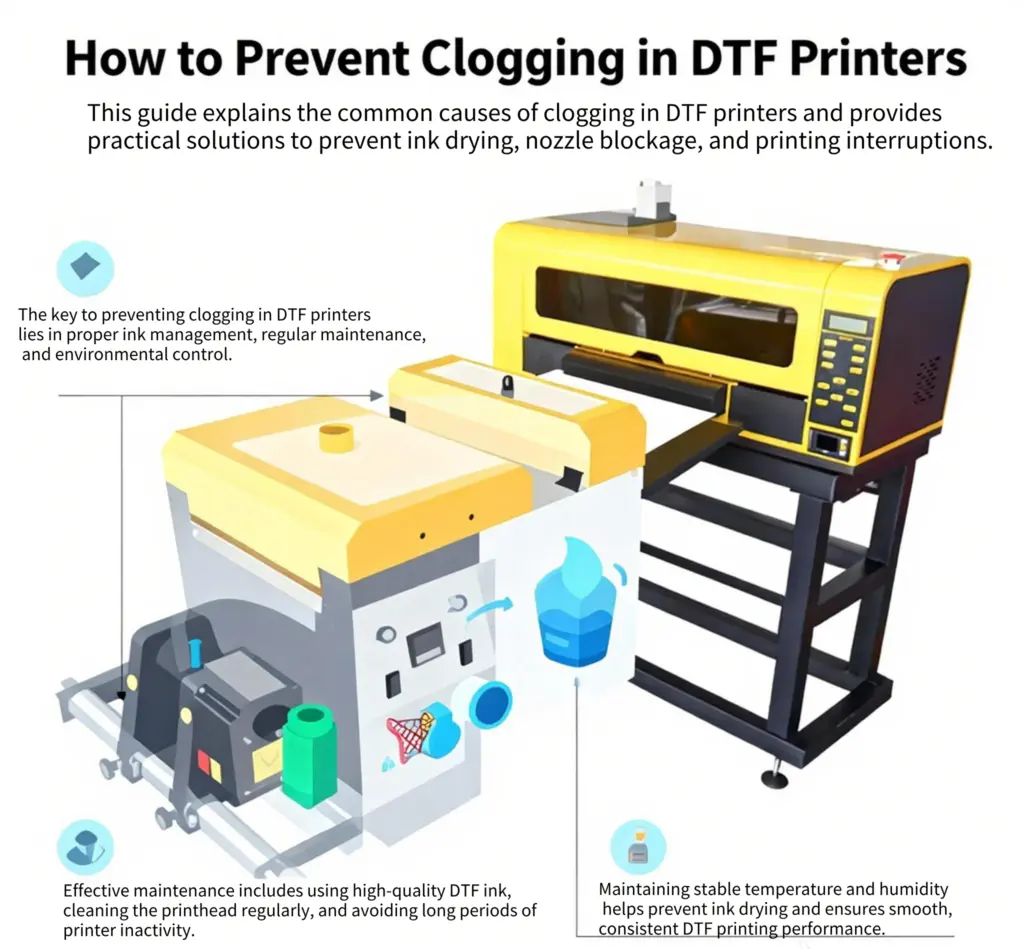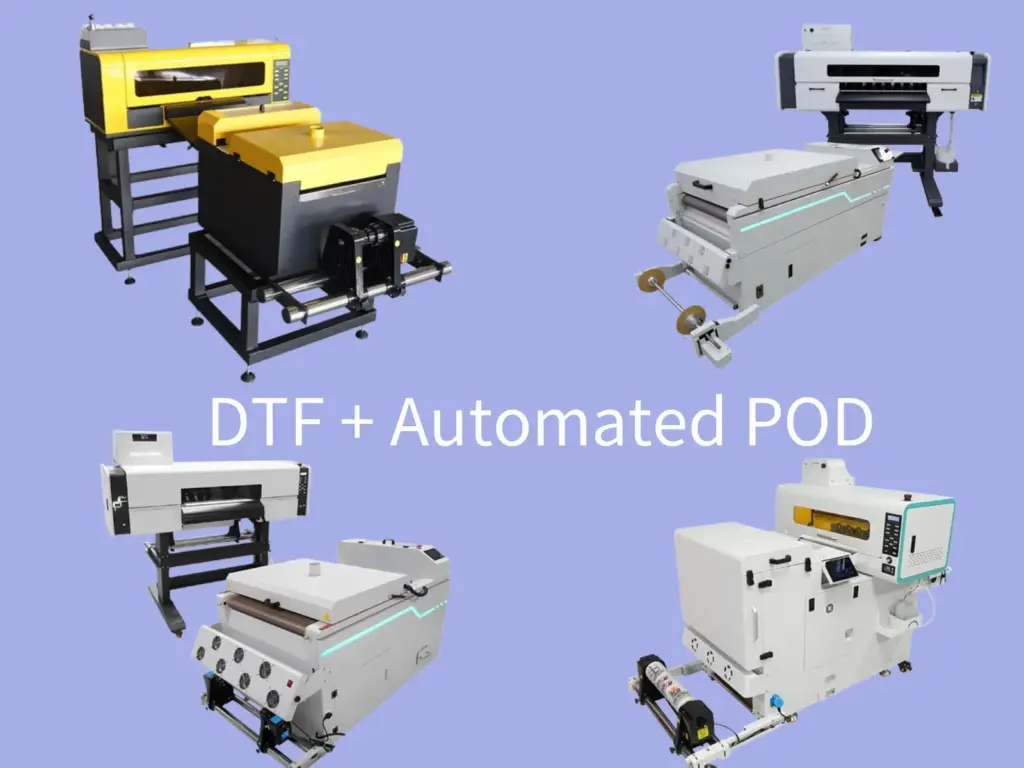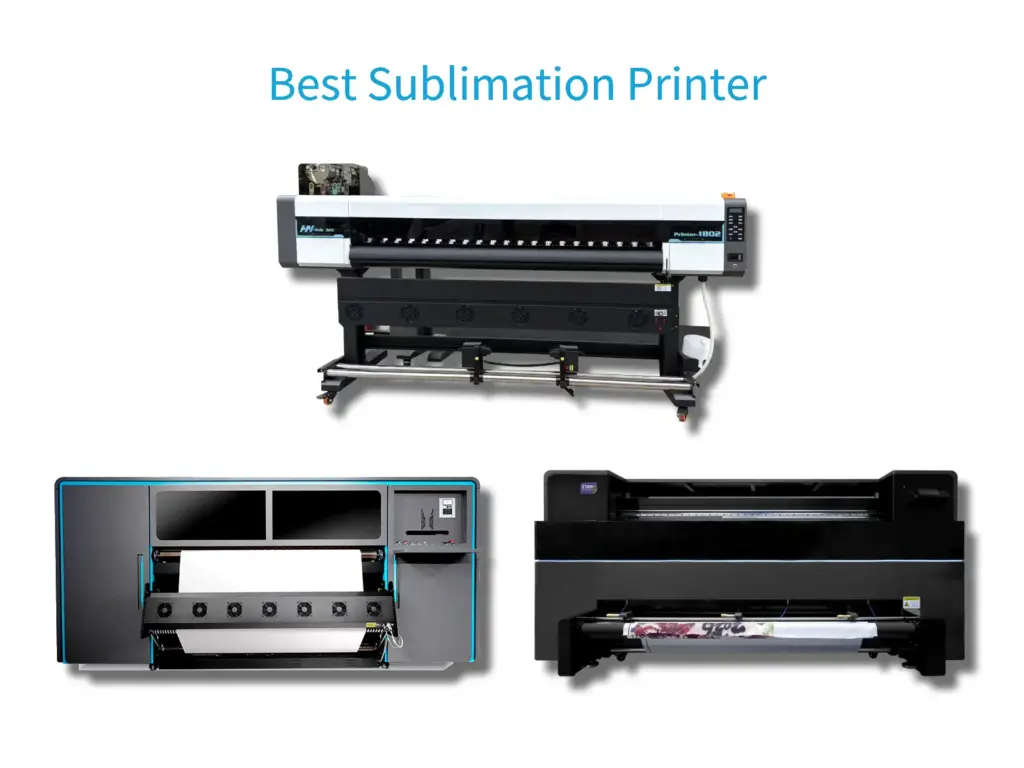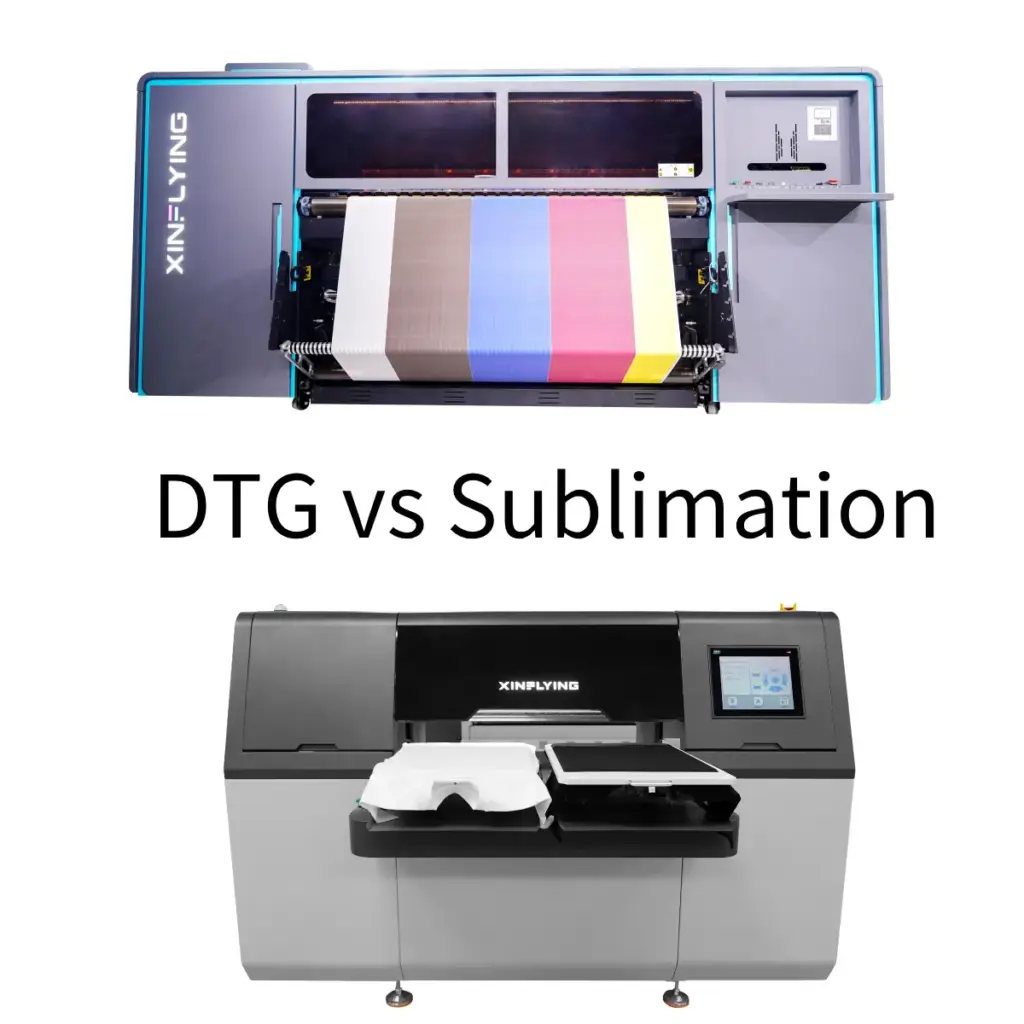การพิมพ์ผ้าเป็นศิลปะที่มีการพัฒนาอย่างมากในช่วงหลายปีที่ผ่านมา, นำเสนอเทคนิคที่หลากหลายเพื่อทำให้การออกแบบเป็นจริง. ไม่ว่าคุณจะประดิษฐ์เสื้อยืดตามสั่ง, การออกแบบผ้าสำหรับแฟชั่น, หรือผลิตรายการส่งเสริมการขาย, เทคนิคการพิมพ์สิ่งทอที่คุณเลือกสามารถสร้างความแตกต่างอย่างมีนัยสำคัญในผลิตภัณฑ์ขั้นสุดท้าย. คู่มือนี้จะเจาะลึก 6 เทคนิคการพิมพ์ผ้าประเภทต่างๆ, สำรวจกระบวนการของพวกเขา, การใช้งาน, ข้อดี, และข้อเสียเพื่อช่วยคุณเลือกวิธีที่ดีที่สุดสำหรับความต้องการของคุณ.
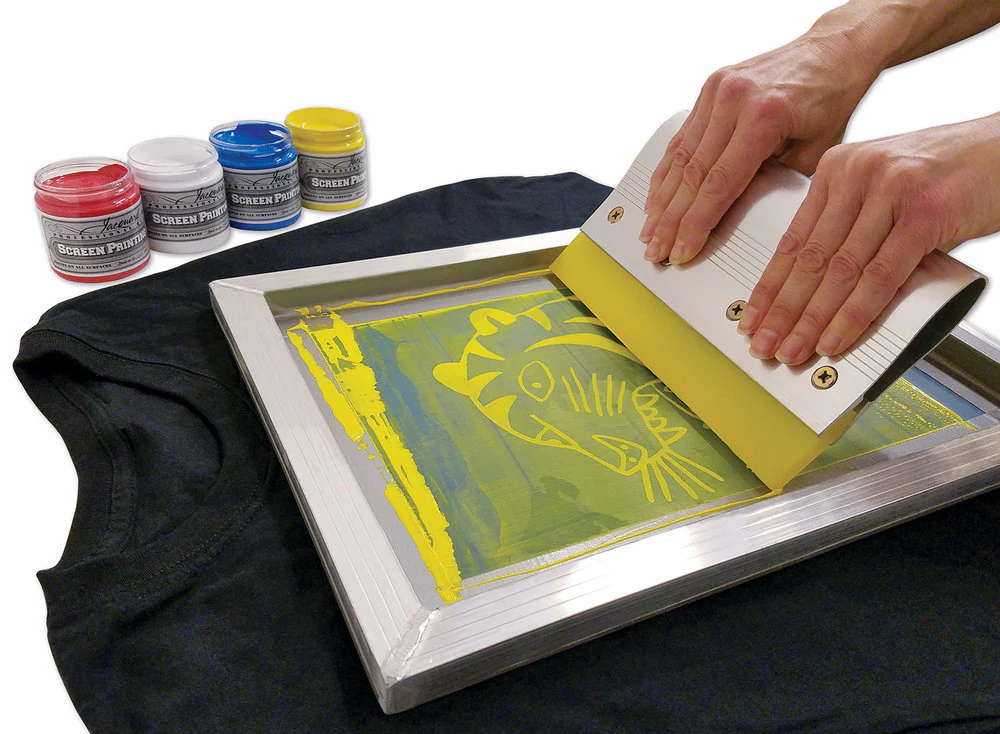
การพิมพ์สกรีน
การพิมพ์สกรีน เป็นหนึ่งในเทคนิคการพิมพ์ผ้าที่เก่าแก่และใช้กันอย่างแพร่หลายมากที่สุด. มันเกี่ยวข้องกับการสร้างลายฉลุ (หรือหน้าจอ) และใช้ทาชั้นหมึกบนพื้นผิวการพิมพ์.
กระบวนการ
กระบวนการเริ่มต้นด้วยการสร้างลายฉลุบนหน้าจอตาข่ายละเอียด. จากนั้นหมึกจะถูกดันผ่านตาข่ายลงบนผ้าโดยใช้ไม้กวาดหุ้มยาง. แต่ละสีในการออกแบบต้องใช้หน้าจอและชั้นหมึกแยกกัน, ทำให้เหมาะกับความเรียบง่าย, การออกแบบที่โดดเด่น.
การใช้งาน
การพิมพ์สกรีนเหมาะอย่างยิ่งสำหรับการสั่งซื้อในปริมาณมากและมักใช้กับเสื้อยืด, ถุงสิริ, และโปสเตอร์. เป็นที่นิยมโดยเฉพาะในอุตสาหกรรมแฟชั่นและการส่งเสริมการขาย.
ข้อดี
- ความทนทาน: สร้างงานพิมพ์ที่มีอายุการใช้งานยาวนานซึ่งสามารถทนต่อการซักซ้ำได้.
- สีสันสดใส: เสนอรวย, สีสันสดใสที่ปรากฏ.
- คุ้มค่า: ประหยัดสำหรับชุดใหญ่.
ข้อเสีย
- เวลาตั้งค่า: ต้องใช้เวลาในการตั้งค่าอย่างมาก, ทำให้มีประสิทธิภาพน้อยลงสำหรับคำสั่งซื้อขนาดเล็ก.
- รายละเอียดจำกัด: ไม่เหมาะสำหรับการออกแบบที่มีรายละเอียดซับซ้อนหรือมีหลายสี.
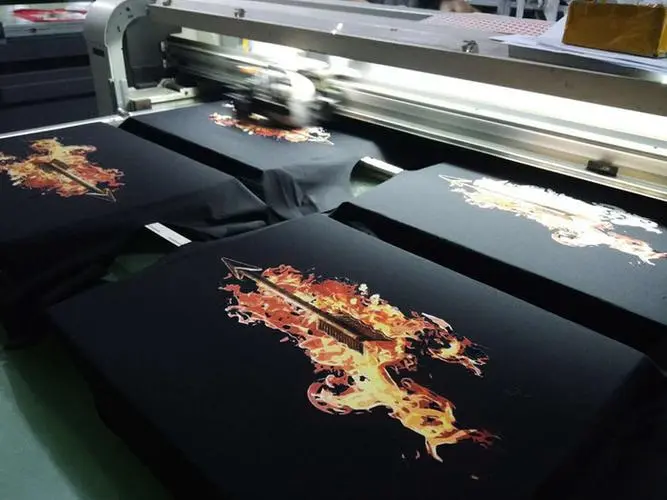
ตรงสู่การ์เม้นท์ (ดีทีจี) การพิมพ์
การพิมพ์ดีทีจี ใช้เทคโนโลยีอิงค์เจ็ทเพื่อพิมพ์ลวดลายลงบนผ้าโดยตรง. ลองนึกถึงเครื่องพิมพ์อิงค์เจ็ทขนาดยักษ์สำหรับเสื้อผ้า.
กระบวนการ
ผ้าถูกโหลดเข้าเครื่องพิมพ์ DTG, โดยที่หมึกถูกทาลงบนพื้นผิวโดยตรง. หมึกซึมเข้าไปในเส้นใย, สร้างงานพิมพ์ที่นุ่มนวลและทนทาน. วิธีนี้เหมาะสำหรับการออกแบบที่มีรายละเอียดและหลายสี.
การใช้งาน
เหมาะสำหรับการสั่งซื้อขนาดเล็กถึงขนาดกลาง, การพิมพ์ DTG ถูกนำมาใช้กันอย่างแพร่หลายสำหรับเสื้อยืดสั่งทำพิเศษ, โดยเฉพาะผู้ที่มีการออกแบบที่ซับซ้อนและมีสีสัน.
ข้อดี
- รายละเอียดและสี: สามารถพิมพ์ภาพความละเอียดสูงพร้อมสเปกตรัมสีที่กว้าง.
- ไม่มีค่าติดตั้ง: เหมาะสำหรับงานชิ้นเล็กๆ และงานสั่งทำพิเศษ.
- ผิวนุ่ม: ให้งานพิมพ์ที่นุ่มนวลต่อการสัมผัส.
ข้อเสีย
- ค่าใช้จ่าย: ต้นทุนต่อหน่วยที่สูงขึ้นสำหรับคำสั่งซื้อที่มากขึ้น.
- ความเร็วช้าลง: เวลาในการผลิตช้าลงเมื่อเทียบกับการพิมพ์สกรีน.

ตรงไปที่ภาพยนตร์ (ดีทีเอฟ) การพิมพ์
ท่ามกลางเทคนิคการพิมพ์ผ้าประเภทต่างๆ, การพิมพ์ DTF โดดเด่นด้วยความสามารถรอบด้าน. การพิมพ์ DTF เป็นการพิมพ์การออกแบบลงบนฟิล์มพิเศษ, จากนั้นจึงถ่ายโอนไปยังผ้าโดยใช้ความร้อนและผงกาว.
กระบวนการ
การออกแบบจะพิมพ์ลงบนแผ่นฟิล์ม PET โดยใช้เครื่องพิมพ์ DTF แบบพิเศษ. ฟิล์มพิมพ์เคลือบด้วยผงกาว, ละลาย, แล้วจึงถ่ายโอนไปยังผ้าโดยใช้เครื่องรีดความร้อน.
การใช้งาน
การพิมพ์ DTF มีความหลากหลาย, เหมาะสำหรับผ้าต่างๆ, รวมถึงผ้าฝ้าย, โพลีเอสเตอร์, และผสมผสาน. มักใช้สำหรับเครื่องแต่งกายสั่งทำพิเศษและรายการส่งเสริมการขาย.
ข้อดี
- ความเก่งกาจ: สามารถพิมพ์บนวัสดุได้หลากหลาย.
- รายละเอียด: จัดการกับการออกแบบที่มีรายละเอียดและหลากสีได้ดี.
- ความทนทาน: สร้างงานพิมพ์ที่ทนทานต่อการแตกร้าวและการซีดจาง.
ข้อเสีย
- ความซับซ้อน: ต้องใช้หลายขั้นตอนและการควบคุมที่แม่นยำ.
- ค่าใช้จ่าย: การตั้งค่าเริ่มต้นและวัสดุอาจมีค่าใช้จ่ายสูง.
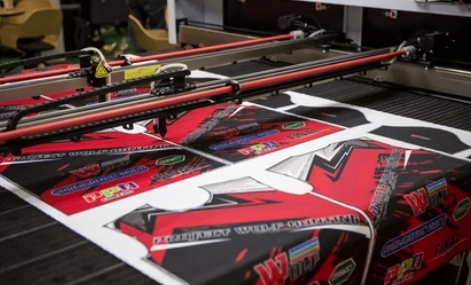
การพิมพ์ระเหิด
การพิมพ์ระเหิด ใช้ความร้อนในการถ่ายสีย้อมผ้า, ส่งผลให้เกิดการออกแบบที่มีชีวิตชีวาและถาวร.
กระบวนการ
การออกแบบถูกพิมพ์บนกระดาษซับลิเมชั่นพิเศษโดยใช้หมึกระเหิด. ใช้ความร้อนและแรงดันเพื่อถ่ายโอนสีย้อมจากกระดาษไปยังผ้า, โดยที่มันเกาะติดกันในระดับโมเลกุล.
การใช้งาน
เหมาะที่สุดสำหรับผ้าโพลีเอสเตอร์และผ้าเคลือบโพลีเมอร์, การพิมพ์แบบระเหิดมักใช้สำหรับชุดกีฬา, ธง, และรายการส่งเสริมการขายที่กำหนดเอง.
ข้อดี
- สีสันสดใส: ให้ผลผลิตสดใส, มีชีวิตชีวา, และสีถาวร.
- การพิมพ์แบบทั่วถึง: เหมาะสำหรับงานพิมพ์แบบเต็มหน้า.
- ความทนทาน: ดีไซน์มีความทนทานและไม่แตกร้าว, ปอก, หรือจางหายไป.
ข้อเสีย
- ข้อจำกัดของผ้า: จำกัดเฉพาะพื้นผิวเคลือบโพลีเอสเตอร์หรือโพลีเมอร์.
- ค่าใช้จ่าย: อาจมีราคาแพงเนื่องจากวัสดุพิเศษ.
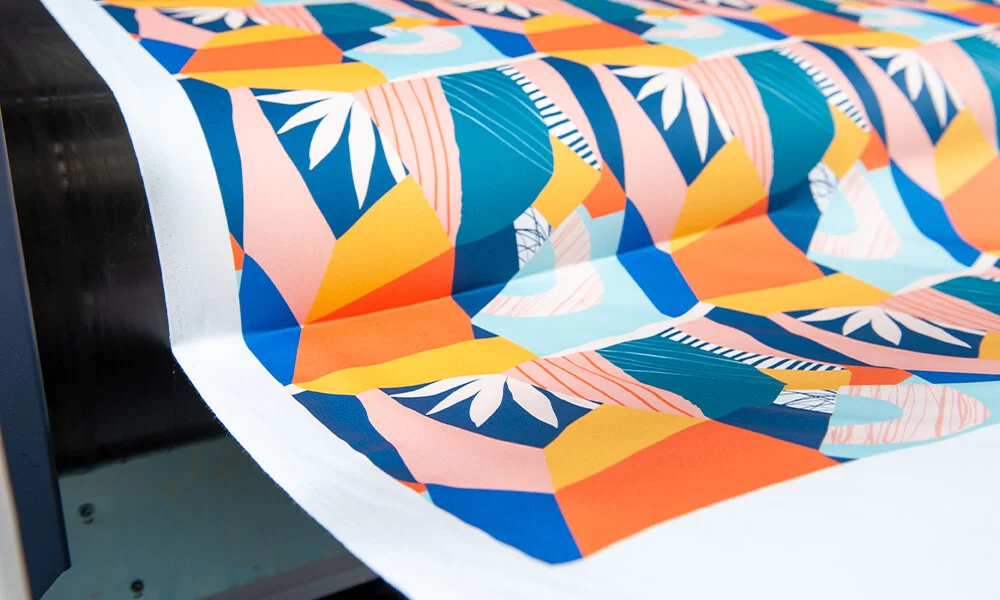
การพิมพ์เม็ดสี
การพิมพ์เม็ดสีใช้หมึกสีที่อยู่ด้านบนของเส้นใยผ้า, แทนที่จะซึมซับ.
กระบวนการ
การออกแบบนี้พิมพ์ลงบนผ้าโดยตรงโดยใช้เครื่องพิมพ์ที่มาพร้อมกับหมึกสี. หลังจากการพิมพ์, ผ้ามักจะถูกตั้งค่าด้วยความร้อนเพื่อแก้ไขเม็ดสี.
การใช้งาน
เหมาะสำหรับทั้งผ้าธรรมชาติและผ้าใยสังเคราะห์, การพิมพ์เม็ดสีถูกนำมาใช้ในแฟชั่น, สิ่งทอที่บ้าน, และเสื้อผ้าตามสั่ง.
ข้อดี
- ความเก่งกาจ: เหมาะสำหรับเนื้อผ้าที่หลากหลาย.
- ความคงทนของสี: ให้ความคงทนของสีที่ดีและความทนทานในการซัก.
- รายละเอียด: สามารถพิมพ์รายละเอียดได้ละเอียดและสีสันสดใส.
ข้อเสีย
- พื้นผิว: ลายพิมพ์อาจรู้สึกแข็งบนพื้นผิวผ้า.
- ซีดจาง: สีอาจจางเร็วกว่าวิธีอื่นหากไม่แก้ไขอย่างเหมาะสม.
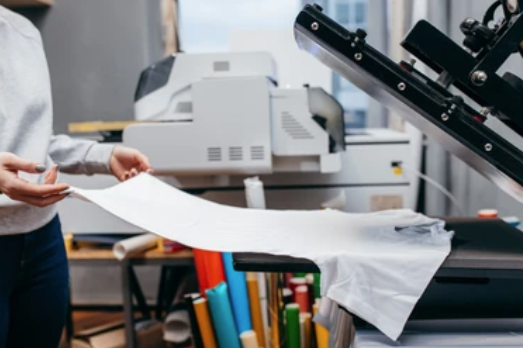
ไวนิลการถ่ายเทความร้อน (เอชทีวี) การพิมพ์
การพิมพ์ HTV เกี่ยวข้องกับการตัดการออกแบบจากแผ่นไวนิลและการกดความร้อนลงบนผ้า.
กระบวนการ
การออกแบบถูกตัดจากแผ่นไวนิลโดยใช้พล็อตเตอร์หรือคัตเตอร์. จากนั้นไวนิลที่ตัดจะถูกกำจัดวัชพืชเพื่อขจัดวัสดุส่วนเกินและกดความร้อนลงบนผ้า.
การใช้งาน
นิยมใช้กับชุดกีฬา, เสื้อยืดที่กำหนดเอง, และรายการส่งเสริมการขาย, การพิมพ์ HTV มีความหลากหลายและเป็นที่นิยมสำหรับการออกแบบครั้งเดียวและการพิมพ์ระยะสั้น.
ข้อดี
- ความทนทาน: ให้งานพิมพ์ที่คงทนและสามารถซักทำความสะอาดได้.
- ความเก่งกาจ: มีให้เลือกหลากหลายสีและพื้นผิว, รวมถึงเมทัลลิกและกลิตเตอร์.
- ใช้งานง่าย: กระบวนการง่ายๆ ที่ไม่ต้องมีการตั้งค่าที่กว้างขวาง.
ข้อเสีย
- พื้นผิว: ลายพิมพ์ไวนิลอาจให้ความรู้สึกหนักและแข็ง.
- รายละเอียดจำกัด: ไม่เหมาะสำหรับการออกแบบที่มีรายละเอียดสูงหรือมีหลายสี.
คุณควรเลือกวิธีการพิมพ์แบบใด?
การเลือกวิธีการพิมพ์ผ้าที่เหมาะสมนั้นขึ้นอยู่กับความต้องการเฉพาะของคุณ. พิจารณาประเภทของผ้า, ความซับซ้อนของการออกแบบ, ขนาดการสั่งซื้อ, และงบประมาณ.
การพิมพ์สกรีน เหมาะสำหรับงานจำนวนมากที่มีดีไซน์เรียบง่าย, ในขณะที่ ดีทีจี เหมาะสำหรับงานพิมพ์แบบกำหนดเองที่มีรายละเอียดและมีสีสัน. ดีทีเอฟ นำเสนอความคล่องตัวทั่วทั้งเนื้อผ้า, การระเหิดให้สีที่สดใสสำหรับโพลีเอสเตอร์, การพิมพ์เม็ดสี ทำงานได้ดีกับวัสดุหลากหลายชนิด, และ เอชทีวี ทนทานเป็นเลิศ, พิมพ์แบบกำหนดเอง.
บทสรุป
การสำรวจโลกแห่งการพิมพ์ผ้าอาจเป็นเรื่องที่ล้นหลาม, แต่การทำความเข้าใจข้อดีและข้อเสียของวิธีการพิมพ์บนผ้าแบบต่างๆ สามารถช่วยแนะนำตัวเลือกที่ดีที่สุดสำหรับโครงการของคุณได้. ไม่ว่าคุณกำลังมองหาความมีชีวิตชีวา, งานพิมพ์ที่คงทนหรือโซลูชั่นที่คุ้มค่าสำหรับการสั่งซื้อจำนวนมาก, มีเทคนิคการพิมพ์ที่เหมาะกับความต้องการของคุณ. พิจารณาประเภทผ้าของคุณ, รายละเอียดการออกแบบ, และปริมาณการผลิตเพื่อการตัดสินใจอย่างมีข้อมูลซึ่งจะทำให้วิสัยทัศน์ที่สร้างสรรค์ของคุณเป็นจริง.
คำถามที่พบบ่อย
1. วิธีพิมพ์ผ้าแบบใดคงทนที่สุด?
การพิมพ์สกรีนและการพิมพ์แบบระเหิดเป็นที่ทราบกันดีว่ามีความทนทาน, ทนต่อการซักหลายครั้งโดยไม่ซีดจางหรือแตกร้าว.
2. ฉันสามารถใช้การพิมพ์ DTF บนผ้าทุกชนิดได้หรือไม่?
การพิมพ์ DTF มีความหลากหลายสูงและใช้ได้กับผ้าหลากหลายประเภท, รวมถึงผ้าฝ้าย, โพลีเอสเตอร์, และผสมผสาน.
3. วิธีพิมพ์ที่ดีที่สุดสำหรับความซับซ้อนคืออะไร, การออกแบบหลายสี?
การพิมพ์ DTG เหมาะสำหรับการออกแบบที่มีรายละเอียดและหลายสี, ให้ความละเอียดสูงและสีสันที่สดใส.
4. การพิมพ์แบบซับลิเมชั่นจำกัดเฉพาะผ้าบางชนิดหรือไม่?
ใช่, การพิมพ์แบบระเหิดทำงานได้ดีที่สุดกับผ้าโพลีเอสเตอร์และผ้าเคลือบโพลีเมอร์เนื่องจากกระบวนการพันธะที่จำเป็นสำหรับสีย้อมเพื่อแทรกซึมเข้าไปในวัสดุ.
5. ฉันจะลดเวลาการตั้งค่าสำหรับการพิมพ์ผ้าได้อย่างไร?
วิธีการต่างๆ เช่น การพิมพ์ DTG และ HTV ใช้เวลาการตั้งค่าน้อยที่สุดเมื่อเทียบกับการพิมพ์สกรีน, ทำให้มีประสิทธิภาพมากขึ้นสำหรับคำสั่งซื้อขนาดเล็กและการซ่อมบำรุงที่รวดเร็ว.

